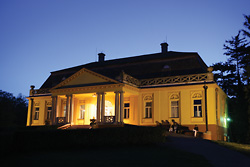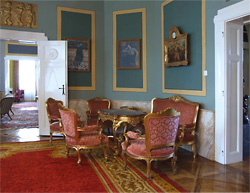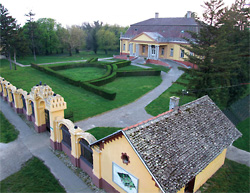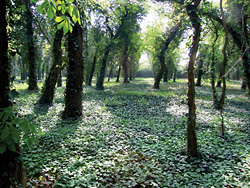Lowland
IN KULPIN, ABOVE NOVI SAD, LIES THE LARGEST AGRICULTURAL MUSEUM IN BALKANS
Through the Meerschaum
There, in the Dunđerski summerhouse, if one listens closely, sometimes a rippling laughter of young ladies and a soft rippled sound of their ball gowns can still be heard. The park, lying on five hectares, English in front and French in the back, longs for its original patron, the one that founded it. Since 1993 in side facilities lies a unique museum in which one might see a sowing machine from the beginning of the 19th century, and a tractor from Rakovica from 1949, and even gain insight in history of hop, brewing, growing wheat, hemp, broomcorn, and witness the rich collection of smoking pipes
By: Zorica Todorović Mirković
 Beneath the whiteness of the snow that gently tucked the wide ploughland, occasionally black černozem clumps, the pride of the people of Bačka, emerge. Černozem is a rare gift of nature, found only in Ukraine and Convelt, the rural part of America, though people from Bačka claim that the one that covers the area of Bački Petrovac and Kulpin can't be found anywhere in the world. Beneath the whiteness of the snow that gently tucked the wide ploughland, occasionally black černozem clumps, the pride of the people of Bačka, emerge. Černozem is a rare gift of nature, found only in Ukraine and Convelt, the rural part of America, though people from Bačka claim that the one that covers the area of Bački Petrovac and Kulpin can't be found anywhere in the world.
Gazing the passing fields, we struck a conversation with uncle Janko, who we have given a ride, while he was heading to Kulpin on foot. The weather is clear with winter sun. Church towers and house roofs emerge gently on the horizon, slowly rising which is a sign that we are near the European capital of the brooms and broomcorn. Uncle Janko Tot, a farmer from Kulpin, points out with great pride that černozem is not their only curiosity. The pride of the village is also a great castle of famous landlord Lazar Dunđerski, a complex in which the Museum of Agriculture has nested, the only in Serbia and the largest in the Balkans.
 – The museum is known beyond our borders. The media are powerful, information and images quickly reach every place, whether true or fabricated, but people with great joy still come to see and touch themselves the old objects, the tools from the past time of honorable patrons, when one lived from the land and for it as well, said a talkative old man. – The museum is known beyond our borders. The media are powerful, information and images quickly reach every place, whether true or fabricated, but people with great joy still come to see and touch themselves the old objects, the tools from the past time of honorable patrons, when one lived from the land and for it as well, said a talkative old man.
With this kind of commentator, we need no curator for the museum complex now. We learn that the most of the locals is doing well in such a role, which makes sense when is commonly known that 10,000 tourists a year, both domestic and foreign ones, visit the village and the museum in it. And as they say you should always be at the guests service, and it would be a great shame that they, the locals, do not know the history of the village and the castle.
UNDER THE OLD LARCH
 In the center of Kulpin, in the street (Maršala Tita Street), whose name has persisted all turmoil in the last twenty years, on one side the Orthodox church of the Ascension of the Lord, and on the other side across the street, hidden behind the long white fence, the majestic castle, the opulent building, with wide porch, colons, dome and tin roof. Beside the so called grand castle, there is a ground villa that also belonged to the previous owners – Stratimirović family. In the center of Kulpin, in the street (Maršala Tita Street), whose name has persisted all turmoil in the last twenty years, on one side the Orthodox church of the Ascension of the Lord, and on the other side across the street, hidden behind the long white fence, the majestic castle, the opulent building, with wide porch, colons, dome and tin roof. Beside the so called grand castle, there is a ground villa that also belonged to the previous owners – Stratimirović family.
There's our host Filip Forkapić, curator of the Museum of Agriculture that is under authority of the Museum of Vojvodina in Novi Sad, with amicable welcome smile.
– It is pretty round here, I can give you that, but in the springtime and summer everything is even prettier when trees and lawn around the castle turn green – he said. – Park has lost its original appearance, but the forest is preserved, where ivy tangles around the trees.
 Riding path, as well as the old walking path, rutted into moss, now covered with snow, is outlined with chestnut alley. While we stroll through the park behind the castle, Mr. Forkapić presents us large splendid larch, which is 120 years old: Riding path, as well as the old walking path, rutted into moss, now covered with snow, is outlined with chestnut alley. While we stroll through the park behind the castle, Mr. Forkapić presents us large splendid larch, which is 120 years old:
– The larch is a must see for our visitors. Many of the trees we planted are unfortunately lost due to the neglect. We are fortunate that this aging beauty, this larch of ours, has avoided similar fate. Though it started its life in South Africa, its roots are now deeply in the Kulpin černozem. It feels good under this sky of ours. It is our darling, a trademark of the castle and this park.
This magnificent park that stretches over five hectares is true monument of nature and habitat to the many rare plants. In front of the castle the park is cultivated in English fashion, while in the back in French fashion. In the forest park, as our host informs us, today there is almost a thousand of chestnut, acacia, linden, and rare conifer trees.
The thought that the tractors, plows, sowing machines, shellers, along other machinery and tools are placed into the castle chambers, is a bit confusing, there where the time has stopped, where the ball gowns still ripple and the rippling laughter of young ladies still echoes while they wait the cavaliers to ask them for a dance. The curator quiets us down showing us the side buildings, old stable and barn. There we have, as he continues, the exhibits that testify on agrarian tradition. Beside the permanent thematic exhibitions which present the history of hop, brewing, growing wheat, hemp, broomcorn, and broom making. The history of cattle, sheep and pig breeding is also presented along the collections of tools and machines for plowing and old agricultural machines.
THE PRIDE OF YU ENGINEERING
 In the museum yard, under the open sky, there is a rare example of steam locomotive for hand threshing, a forerunner of harvester more then a century old. With a tall black smokestacks, throttles, rods and flywheels, this machine has zoomed the fields in the past twirling the chaff and straw dust. In the museum yard, under the open sky, there is a rare example of steam locomotive for hand threshing, a forerunner of harvester more then a century old. With a tall black smokestacks, throttles, rods and flywheels, this machine has zoomed the fields in the past twirling the chaff and straw dust.
Some of the exhibits are a rarity, and even bigger and richer museums in Serbia would envy us on them. For example, we have here, first and now the only tractor produced in ”Industrija motora” in Rakovica in 1949 in former Yugoslavia. Even back then only three prototypes were produced – olive grey robust machines with ”Zadrugar T – 08” label. Despite its numerous shortcomings, it was a pride of Yugoslav engineering, our pride.
Mr. Forkapić presents us another treasure: a sowing machine of wheelwright production from the beginning of the XX century. It is a gift from Zoran Milinković from Mladenovac whose grandfather has single-handedly made that sowing machine, unique in design and manufacture method.
– In the villages in all parts of the Serbia, still one might find interesting machines or tools of museum value. – says Filip Forkapić. – Here, this windmill, used for wheat sieving is a gift from one family from Futog. Hand sprinkler produced in 1950's we also received as a present: Mrs. Mirjana Pavlović from Novo wanted to preserve it and enlarge museum collection that way. The sprinkler belonged to her father Dimitrije Janković, former professor of Sremski Karlovci Gymnasium, which he used in his orchards.
Oh, what treasures exist in the museum! One could easily spend hours just browsing the collection of smoking pipes: precious, ceramic, porcelain, wooden, ”English”, and meerschaum ones... The exhibition of coats of arms from places in Vojvodina that contain some agriculture insignia: a tool, wheat ear, an apple, etc. also seizes attention....
Particularly interesting is the exhibition of the brooms. Dr Janoš Berenji, the author of the exhibition on the broomcorn and broom making, says that the broom is mentioned in Bible nine times, and it can be seen on the Egyptian drawings as well. We encounter it in Romans, where shrine cleaning had a significance and power of the ceremony, representing the honor.
TO BE CHECKED IN KULPIN
 Filip Forkapić knows all the available details about the museum and castle that once belonged to the renowned Dunđerski family. It is not certain when the building was constructed, but its first owners were family Stratimirović, whose offspring was Stefan, the Archbiscop of Karlovac, the founder of Karlovac Gymnasium and Theology University. It is written in annals that in 1863, the castle was sold to the Hungarian aristocrat Matej Semzo, who soon after sold it along with all facilities to Lazar Dunđerski. Filip Forkapić knows all the available details about the museum and castle that once belonged to the renowned Dunđerski family. It is not certain when the building was constructed, but its first owners were family Stratimirović, whose offspring was Stefan, the Archbiscop of Karlovac, the founder of Karlovac Gymnasium and Theology University. It is written in annals that in 1863, the castle was sold to the Hungarian aristocrat Matej Semzo, who soon after sold it along with all facilities to Lazar Dunđerski.
The rich aristocrat has assigned the castle, used as a summerhouse, to his son Đorđe. After the long and cold winter, Dunđerski family has moved from Novi Sad to Kulpin. Here, in the shade and bloom of the village, they spent the hot summers. The doors of the castle were always wide open for dear guests, among which were members of Karađorđević family (cousinly line).
– Today in this luxurious building, occasionally concerts, literary and music events are given – says the curator. – Last year, in luxurious castle chambers the TV show ”All Those Plains” was filmed. It was a grand event both for locals and a castle itself. The viewers of this TV show could have enjoyed in the beauty of the ambiance and period furniture in the castle, in the glitter of cupboards, writing desks, sofas, various armchairs, tables and chairs, from various periods ranging from baroque to empire and neo-biedermeier style.
The pieces of this furniture, that once adorned civil and aristocratic homes, today represent a certain memoirs of the past, a memory of true craftsmen who made them and wealthy men who ordered them not by chance, but understood them and knew how to enjoy them.
Does it have to do anything with the agriculture?
Maybe, but it doesn't hurt to head to Kulpin and see it for yourself.
***
Credits
A long with the other things, after the World War II the majestic castle was nationalized. It hosted the cooperative farm for some time, and it was used as kindergarten as well. The most thankworthy for the opening of the Museum of the Agriculture in 1993, is by far Professor Dr Jan Kišgeci. He is the author and coauthor of numerous exhibitions, which are now permanent in museum: on brewing, hop, hemp, etc.
***
With Rosemary Scent
In Kulpin, in priestly family, Serbian patriarch Georgije Branković was born. It is know for various scenic ethno events and manifestations that attract a number of tourists. Each second week of July the famous ethno event is held here ”Wedding now and then”. Having in mind that the inhabitants are mostly Slovaks and Serbs, most wide spread are the wedding customs of these nations, among others. Anyway, it is important to adorn the nuptials with rosemary, maiden blouses and bachelor lapels, so the entire village smells of rosemary. The entire village.
|
